With counterfeit currency amounting to millions of bills every year, driven by advancements in printing technology, central banks have been enhancing their banknotes with various advanced security features. From holograms and hidden images to microprints and colour-shifting inks, these elements are designed to thwart even the most skilled fraudsters. However, not all currencies are equally protected.
To identify which banknotes are the most secure and which are most vulnerable to counterfeiting attempts, the currency team at BestBrokers looked at the 39 most traded currencies by value as of 2022. We identified the highest-circulating banknote in each country for 2023 and ranked these notes based on their number of security features. We also estimated how many counterfeit notes exist per million real ones across each nation. To see how much cash is there per person, we divided each country’s total value of banknotes by its population.
We found that while the U.S. dollar remains the world’s most traded currency, it’s not the best protected against counterfeiting. The title of the most counterfeit-proof banknote actually belongs to the 100-franc note, released on September 12, 2019, as part of the Swiss franc’s ninth series. The note boasts at least 20 cutting-edge security features, making it nearly impossible to fake.
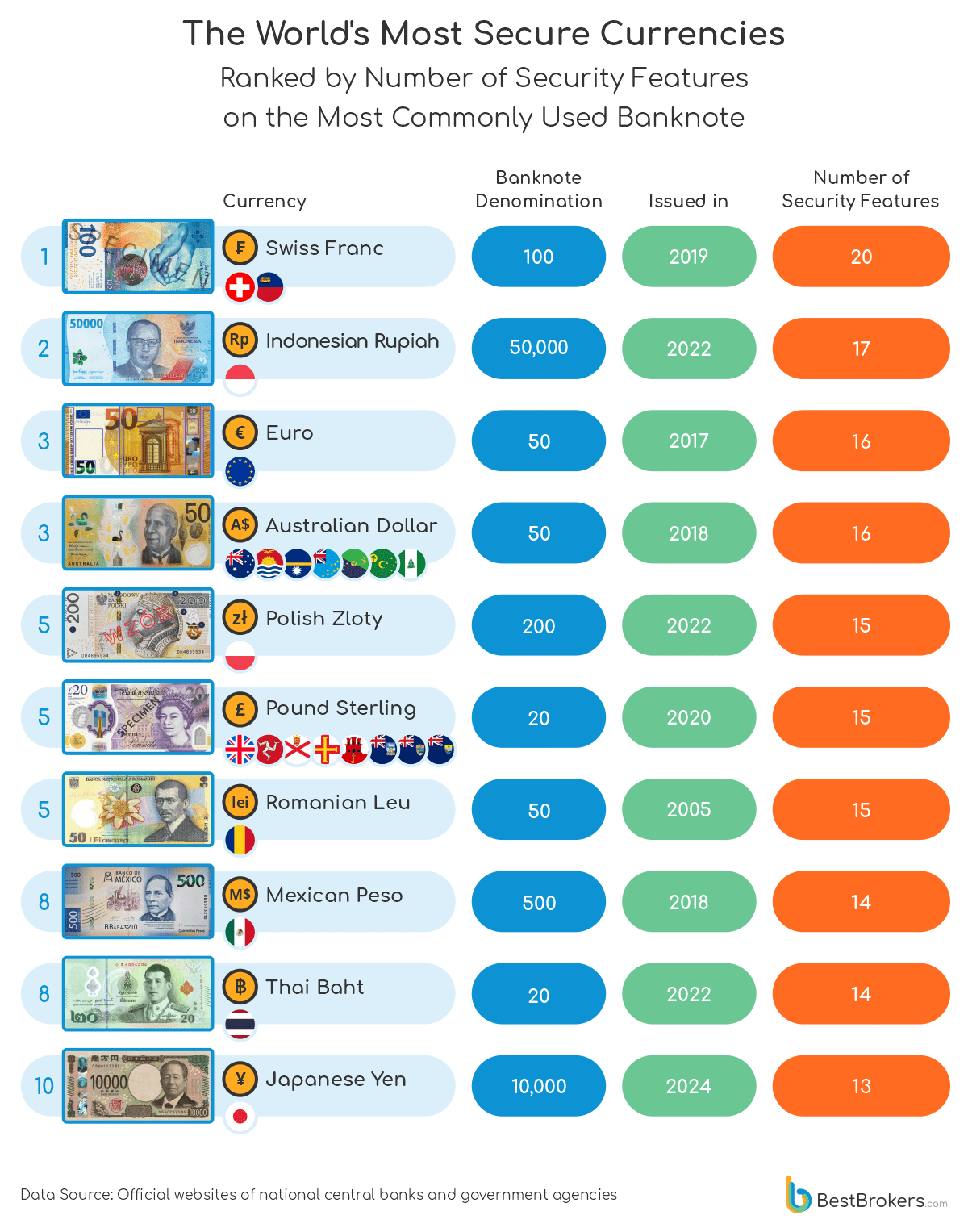
The Hardest Banknotes to Fake in the World
In some countries, higher-value banknotes often have more security features to make them harder to fake. Meanwhile, some governments choose to apply the same protection elements across all their banknotes, regardless of denomination. For our security features ranking, however, we considered only the most commonly circulated banknote from each currency.
100 Swiss Francs, 2019 Issue
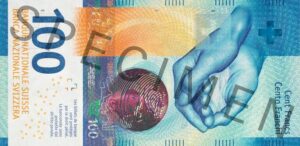
The 100-franc banknote is equipped with 20 advanced security features, making it the hardest to counterfeit among the banknotes we reviewed. These features include a see-through register (a pattern printed simultaneously on both sides of the note), security thread, raised printing, watermark, micro-perforations, infrared properties, UV-visible elements and a pattern called EURion constellation. By the end of 2023, 144.3 million of these 100-franc notes were in circulation, representing 27.22% of Switzerland’s 530 million total banknotes. This makes it the most widely used denomination in the country. The Swiss franc, which is legal tender in Liechtenstein as well, is often seen as a safe-haven asset by investors, thanks to Switzerland’s political neutrality, strong monetary policies, and low national debt. The Swiss franc also ranks as the eighth most traded currency globally by value.
50,000 Indonesian Rupiahs, 2022 Issue
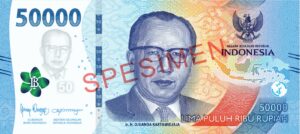
Indonesia’s most frequently used banknote, the 50,000 rupiah note, released on 17th August 2022, comes second with 17 cutting-edge anti-fraud features. These include a watermark featuring the image of Ir. H. Djuanda Kartawidjaja and a magnetic security thread that becomes visible when held up to the light. The note also incorporates tactile features to help blind and partially sighted individuals identify its value, a hidden image and microprinting that can only be read with a magnifier.
50 Euros, 2017 Issue
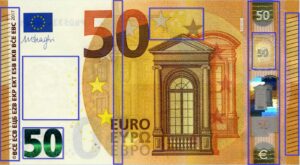
In third position, the 50 Euro note and the 50 Australian Dollar boast 16 complex security features each. These include holograms, see-through elements, transparent windows, intaglio printing, and inks that change colour depending on the angle. The Euro, used by 20 European Union countries, is the second most traded currency in the world, right after the U.S. dollar. There were over 14.6 billion 50 Euro notes in circulation at the end of 2023, according to the European Central Bank. It is by far the most widely circulated denomination across the Eurozone, accounting for almost half of all Euro banknotes. This particular note was introduced on 4 April 2017 as part of the “Europa series,” the second generation of Euro banknotes.
50 Australian Dollars, 2018 Issue
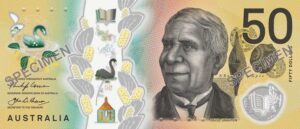
In Australia, the 50-dollar bill, launched on 18 October 2018 and often nicknamed the ‘pineapple’ because of its yellowish colour, is the most widely circulated note. According to the country’s central bank, it accounts for the majority of banknotes dispensed by ATMs. Beyond Australia and its territories, the Australian dollar is also legal tender in three Pacific Island nations: Kiribati, Nauru, and Tuvalu. Australian banknotes are made from durable polymer and are renowned for their nearly impossible-to-counterfeit security features.
Other Counterfeit-Proof Banknotes
Next in line, packed with 15 anti-counterfeiting elements each, are the 200 Polish zloty, the 20-pound sterling, and the 50 Romanian lei. Other banknotes that will be extremely difficult for fraudsters to replicate are the 500 Mexican pesos, and the 20 Thai baht, each with 14 security features. The 10,000 Japanese Yen note, which began circulating recently on July 3, 2024, includes a unique three-dimensional portrait of Shibusawa Eiichi, widely known as the “father of Japanese capitalism.” The portrait shifts direction based on the angle at which it’s viewed.
Although the U.S. dollar is the most widely used and traded currency globally, its $100 bill lags behind banknotes from countries like South Korea, the Philippines, New Zealand, and Russia when it comes to complexity and number of security features. In 2023, there were 18.9 billion such notes in circulation. Because it’s a prime target for counterfeiters, along with the $20 bill, the $100 note was redesigned in 2013 with some extra security features added, such as a 3D blue security ribbon and a colour-changing bell. These updates brought its total number of anti-counterfeiting elements to 12.
Of course, banknotes with fewer security features are often more vulnerable to counterfeiting compared to those with more complex designs. For instance, both the 100 South African Rand and the 1,000 Taiwan New Dollar notes have only nine security features, making them easier targets for counterfeiters. The same goes for the 5 Bahraini dinars and the 2,000 Argentine pesos as they too have only nine security features.
The Most Common Security Features on Banknotes
Security features on banknotes typically fall into two categories: those that are visible to the naked eye and those that require special equipment, such as a magnifying glass, ultraviolet (UV) lamp, or infrared viewer, to detect.
To identify the most widely used security features on banknotes, we selected two denominations from each of the 39 most traded currencies: the highest-value note and the one most commonly found in circulation. If these two overlapped, we added a second banknote to ensure we had two examples per currency. Among the 78 banknotes examined, intaglio, or raised printing, emerged as the most common security feature. This technique creates a tactile texture you can feel by running your fingers over the note and is often found in areas like portraits or large numbers. It is created using a high-pressure printing process, making the note harder to reproduce with regular printers.
Seventy-two banknote denominations around the world use watermarks for protection, making them the second most popular anti-counterfeiting measure on our list. These subtle images, often a portrait or emblem, are embedded directly into the paper during the manufacturing process and can only be seen when held up to light. The U.S. $100 bill, for instance, carries a watermark of Benjamin Franklin, while U.K. banknotes display a portrait of Queen Elizabeth II.
Tactile features to assist the visually impaired and microprinting are the next most widely used security elements, each incorporated on 71 and 69 of the banknotes we examined, respectively. Tactile features involve raised patterns or symbols, allowing individuals with visual impairments to distinguish between denominations by touch. On the other hand, microprinting consists of ultra-small text, which appears as a simple line or pattern to the naked eye but can be read clearly with magnification. These tiny texts can be found on banknotes from various currencies, including the Hungarian Forint, Norwegian Krone, Singapore Dollar, and Czech Koruna.
Other popular security features against counterfeiting include:
- Colour-shifting ink (found on 68 banknotes): Ink that changes colour when viewed from different angles, often used on numbers or key symbols to make counterfeiting more difficult.
- Ultraviolet (UV) features (found on 68 banknotes): Special fibres, numbers, or symbols that glow under UV light but remain invisible under normal lighting conditions.
- Security threads (found on 66 banknotes): A thin metallic strip embedded in the note, visible when held up to light. It may include microtext or change colours under different lighting.
- See-through features (found on 64 banknotes): A design printed on both sides of the note that aligns perfectly when held to the light, forming a complete image or pattern.
- Latent (hidden) images (found on 56 banknotes): Images that remain hidden unless the note is tilted at a specific angle, making them hard to replicate.
- Holograms (found on 56 banknotes): Holographic images that change appearance when viewed from different angles, often showing 3D effects or colour shifts to enhance security.
Currencies with the Highest Number of Counterfeit Banknotes Detected in 2023
The Secret Service, the federal agency responsible for suppressing counterfeit notes, does not publish details about the number and denomination of fake banknotes it encounters for security reasons. Based on data from previous years, however, our rough and very conservative estimation is that at least 904,700 fake notes were detected in 2023. This makes the U.S. dollar the most counterfeited currency that year. Although this sounds like a lot, it pales compared to the scale of counterfeiting during the Civil War era. Back in 1865, a staggering one-third to one-half of all U.S. currency in circulation was estimated to be fake. As of last year, the most commonly faked bills were the $20 and $10 notes, and for every million legitimate U.S. banknotes, there were about 17 counterfeit ones. Additionally, it is estimated that between one-half and two-thirds of the total value of U.S. currency circulates outside the United States.
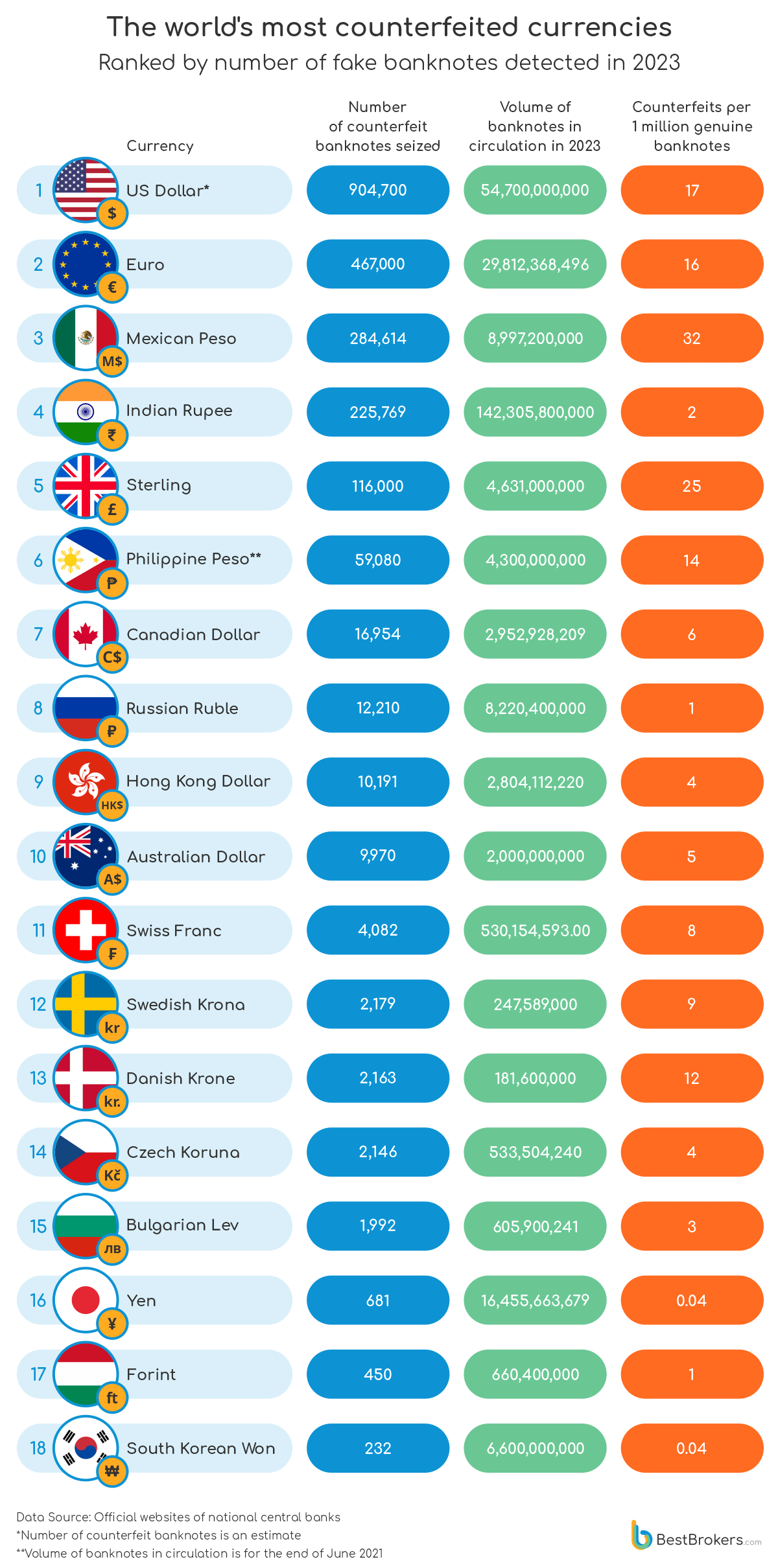
Despite the Euro’s many state-of-the-art anti-counterfeiting features, it was the second most counterfeited currency last year, with 467,000 fake notes withdrawn from circulation. This translates to 16 counterfeit bills for every million genuine banknotes in use, one of the lowest rates since euro banknotes were introduced on January 1, 2002, according to the European Central Bank. The €20 and €50 denominations were the most commonly counterfeited denominations, making up over 70% of the total fakes. Statistics show that 97.2% of these counterfeit notes were detected within euro-area countries, 1.9% in non-euro EU member states, and 0.9% in other parts of the world. In Germany alone, approximately 56,600 counterfeit euro notes were detected in the first half of 2023.
In 2023, the Bank of Mexico reported 284,614 counterfeit peso notes, placing the Mexican Peso third in terms of seized fake currency. The 500 and 200 peso notes were the most commonly counterfeited. With nearly 9 billion banknotes in circulation, Mexico had the highest ratio of counterfeits per one million genuine notes, at 32. India, on the other hand, registered 225,769 counterfeit notes in 2023, but given the massive volume of banknotes in circulation (142.3 billion), this resulted in only 2 counterfeits per million banknotes.
In the UK, 116,000 counterfeit British pounds were seized last year, valued at £2.4 million, with the £20 note being the most commonly faked. With 4.6 billion banknotes in circulation, this meant that 25 counterfeits were detected for every million legitimate notes. Russia, for comparison, reported 12,210 counterfeit rubles, and with 8.2 billion banknotes in circulation, only 1 counterfeit per million notes was found. Meanwhile, South Korea recorded one of the lowest counterfeit ratios globally, with just 0.04 counterfeits per million banknotes.
Nations with the Most Wealth per Person
When it comes to cash per person, Switzerland holds the top spot with a remarkable $10,082 in cash for every citizen. To arrive at this per capita figure, we divided the country’s total amount of cash in circulation, converted in U.S. dollars, by its population. By the end of 2023, 530 million Swiss francs were in circulation, valued at CHF76.3 billion. In U.S. dollars, that comes to a whopping $90.8 billion.
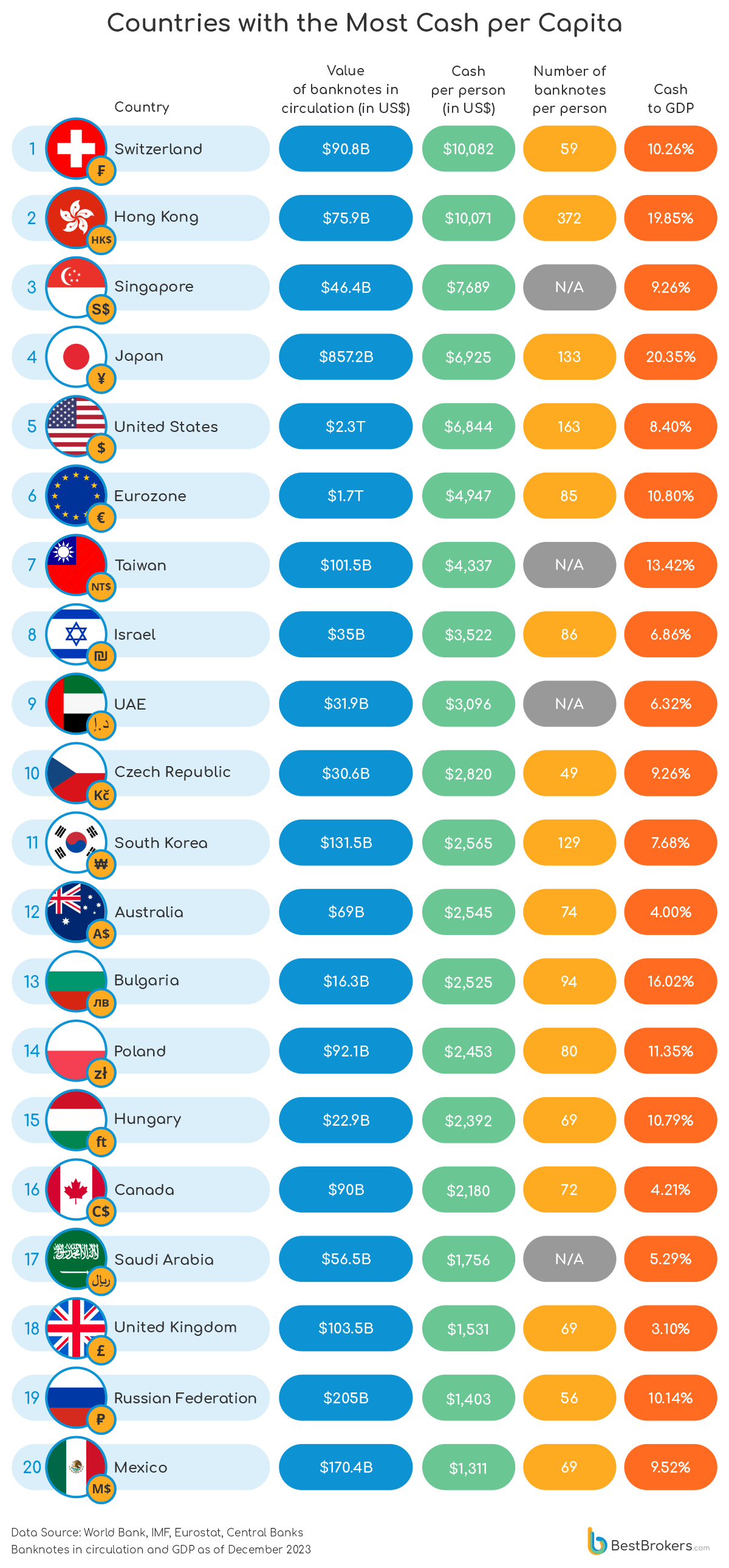
Hong Kong comes in a close second, with individuals holding $10,071 on average. Unlike Switzerland, Hong Kong has many more notes per capita, at 372 banknotes per person on average. The total value of these banknotes adds up to $75.9 billion, which represents a significant 19.85% of the country’s GDP.
Singapore follows with $7,689 in cash per person, while Japan ranks fourth with $6,925. Interestingly, the total value of Japan’s banknotes in circulation makes up a notable 20.35% of its GDP, which stood at $4.21 trillion in 2023. The United States, the world’s largest economy, has $6,844 in cash per person. There were 54.7 billion banknotes in circulation by the end of 2023, worth $2.3 trillion. The cash-to-GDP ratio is lower than that of Japan or Hong Kong, standing at 8.40%.
The Eurozone, which includes multiple countries using the euro, has an average of $4,947 in cash per capita. The total value of banknotes in circulation across the Eurozone is around $1.7 trillion, with a cash-to-GDP ratio of 10.80%. In contrast, Denmark holds the least amount of cash relative to its population, with only $154 in cash per person.
Raw Data
The complete list of banknotes analysed is available via this link. The Google Drive spreadsheet also includes all data we compiled about the currencies and the countries they are legal tender in such as population, gross domestic product, cash in circulation, and counterfeit bills intercepted in 2023.
Methodology
To compile this report, the team at BestBrokers looked at the 39 most traded currencies by value as of 2022. For each country, we identified the banknote with the highest volume in circulation for 2023. We then ranked these notes based on the number of security features they incorporate, with data sourced from national central banks and government agencies.
We also calculated how many fake notes exist for every million real ones, which is a widely used metric in tracking counterfeit currency. Our team did this by comparing the number of counterfeit notes seized in 2023 to the total number of banknotes in use.
Finally, to rank the nations based on how much cash there is per person, we divided each country’s total value of banknotes in circulation by its population (official estimates and Eurostat data). These amounts were converted into U.S. dollars using December 2023 exchange rates. We also determined each nation’s cash-to-GDP ratio by comparing the total worth of cash in circulation to its GDP in 2023.
Additional sources of information used:
